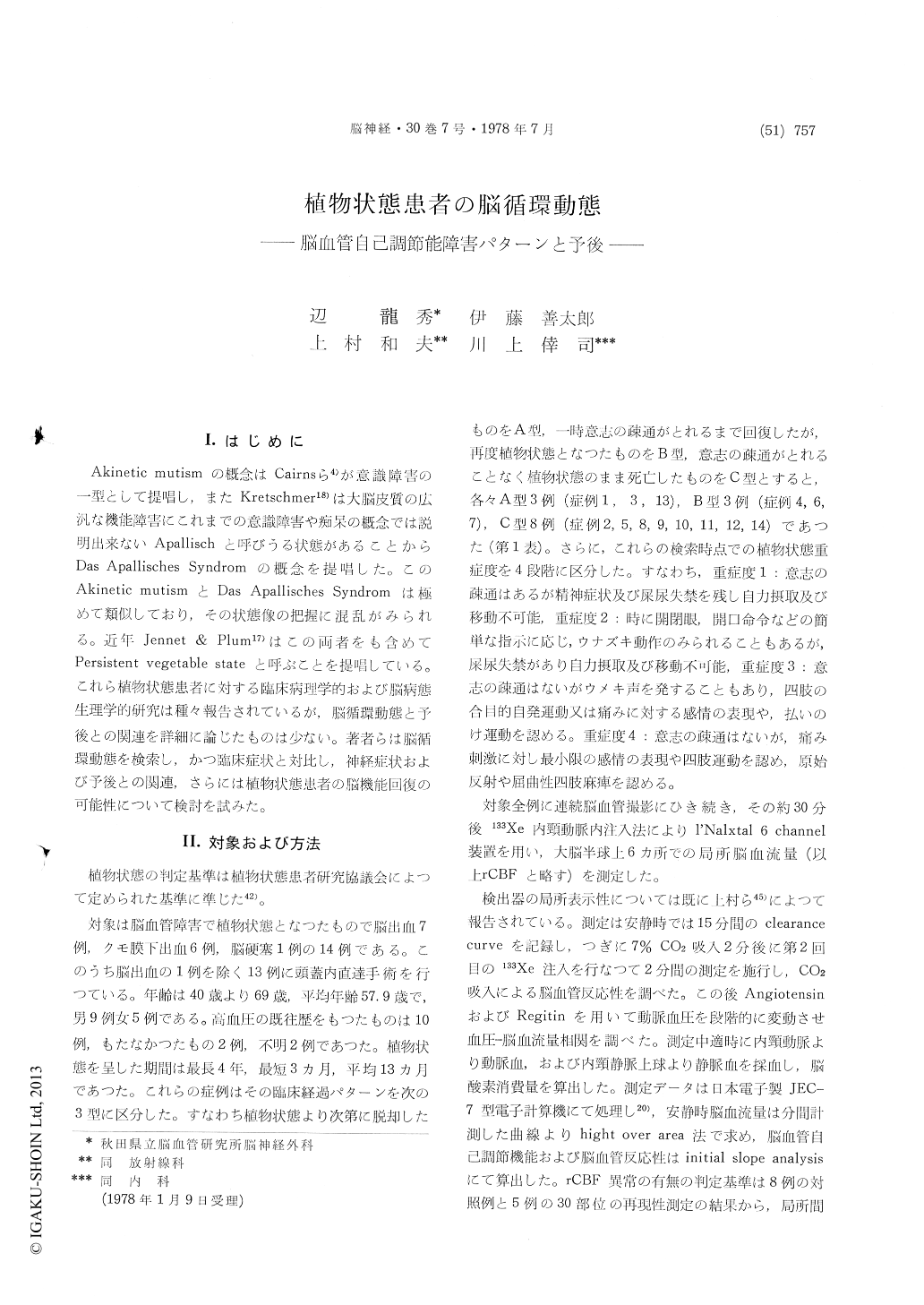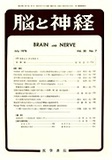Japanese
English
- 有料閲覧
- Abstract 文献概要
- 1ページ目 Look Inside
I.はじめに
Akinetic mutismの概念はCairnsら4)が意識障害の一型として提唱し,またKretschmer18)は大脳皮質の広汎な機能障害にこれまでの意識障害や痴呆の概念では説明出来ないApallischと呼びうる状態があることからDas Apallisches Syndromの概念を提唱した。このAkinetic mutismとDas Apallisches Syndromは極めて類似しており,その状態像の把握に混乱がみられる。近年Jennet & Plum17)はこの両者をも含めてPersistent vegetable stateと呼ぶことを提唱している。これら植物状態患者に対する臨床病理学的および脳病態生理学的研究は種々報告されているが,脳循環動態と予後との関連を詳細に論じたものは少ない。著者らは脳循環動態を検索し,かつ臨床症状と対比し,神経症状および予後との関連,さらには植物状態患者の脳機能回復の可能性について検討を試みた。
The pathophysiological analysis of cerebral hemo-dynamic mechanisms and its metabolism in the vegetative patients was not enough until now. It was reported in this paper that the correlation between cerebral hemodynamics, metabolism and neurological function was analysed in 14 patients with vegetative state caused by cerebrovascular disorders.
The materials consist of 14 vegetative patients due to 7 hypertensive intracerebral hemorrhage, 6 subarachnoid hemorrhage and one cerebral infarction.
In all of them, the cerebral hemodynamics such as cerebral blood flow (CBF), CO2 reactivity and autoregulation, and cerebral metabolism were measured sequencially by 133Xe clearance methods.
In the majority of cases, both values of mean hemispheric CBF and cerebral oxygen consumption (CMRO2) were markedly decreased with severe impairments of autoregulation and CO2 reactivity on the bilateral hemispheres but much more sig-nificantly on the affected hemispheres.
Futhermore, from view points of the pressure-flow relationship in the CBF studies, the patterns of dysautoregulation could be classified into 2 types as follows ;
Type 1 is the complete loss type, which has no plateau formation in all ranging of systemic arterial blood pressure (SABP).
Type 2 is the incomplete loss type with 2 sub-divisions, in which the abnormal narrowing plateaus are recognized in relatively higher or lower range of SABP (called as the upper or the lower type of incomplete loss type respectively).
And then, the phenomen, which we gave a term as "shift-off phenomenon ", was recognized in 8 cases that the proper values of resting SABP was seated outside the plateau level of the auto-regulatory capacity.
The correlation between CBF dynamics and the grade of vegetative state was analysed.
In 2 cases with slight communications (vegetative grade 1), mean hemispheric CBF value was 32.5 (ml/100 g/min.) and CMRO2 was 2.01 (ml/100 g/ min.) with the normal or the upper type in incomplete loss of dysautoregulation.
In 3 cases of vegetative grade 2, who could slightly response to vocal order, mean CBF and CMRO2 showed 27.0±2.0 and 1.7 ± 0.08 respective-ly. In these cases, dysautoregulations with the upper type incomplete loss were recognized.
In 3 cases of vegetative grade 3, who had only spontaneous movement of body and slight emotional expression but no response to vocal order, mean CBF was in 22.4±1.9 and CMRO2 in 1.28 ± 0.21. The patterns of dysautoregulation showed the lower type of incomplete loss.
The values of mean CBF and CMRO2 of 5 patients in vegetative grade 4, who had only primary reactions by pain stimulations, markedly de-creased in 18.0±2.5 and 0.87 ±0.06 respectively. The patterns of dysautoregulation were the lower type of incomplete or complete loss.
We had experienced the shift-off phenomenon in all of 5 cases with the upper type of incomplete loss and in 3 of 7 cases with the lower type of incomplete loss dysautoregulation.
As conclusion, in cases of vegetative grade 2 or 3 whose patterns of dysautoregulation are the upper or lower type of incomplete loss with the shift-off phenomenon, it would be a useful therapeutic method to get away from vegetative state that SABP could be corrected and controlled within the proper plateau level of autoregulation by the suitable administration of some vasoactive agents.

Copyright © 1978, Igaku-Shoin Ltd. All rights reserved.


